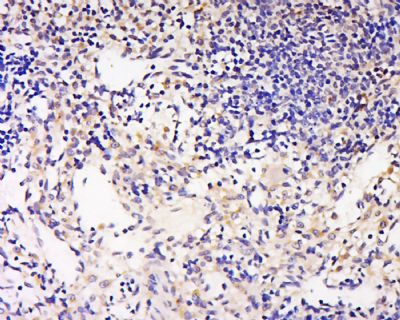GAL3ST2 Polyclonal Antibody
Purified Rabbit Polyclonal Antibody (Pab)
- SPECIFICATION
- CITATIONS
- PROTOCOLS
- BACKGROUND

Application
| IHC-P, IHC-F, IF, ICC, E |
|---|---|
| Primary Accession | Q9H3Q3 |
| Reactivity | Rat, Pig, Dog, Bovine |
| Host | Rabbit |
| Clonality | Polyclonal |
| Calculated MW | 46 KDa |
| Physical State | Liquid |
| Immunogen | KLH conjugated synthetic peptide derived from human GAL3ST2 |
| Epitope Specificity | 1-100/398 |
| Isotype | IgG |
| Purity | affinity purified by Protein A |
| Buffer | 0.01M TBS (pH7.4) with 1% BSA, 0.02% Proclin300 and 50% Glycerol. |
| SUBCELLULAR LOCATION | Golgi apparatus; Golgi stack membrane. |
| SIMILARITY | Belongs to the galactose-3-O-sulfotransferase family. |
| Important Note | This product as supplied is intended for research use only, not for use in human, therapeutic or diagnostic applications. |
| Background Descriptions | This gene encodes a member of the galactose-3-O-sulfotransferase protein family. The product of this gene catalyzes sulfonation by transferring a sulfate group to the hydroxyl at C-3 of nonreducing beta-galactosyl residues, and it can act on both type 1 and type 2 (Galbeta 1-3/1-4GlcNAc-R) oligosaccharides with similar efficiencies, and on core 1 glycans. This enzyme has been implicated in tumor metastasis processes. This gene is different from the GAL3ST3 gene located on chromosome 11, which has also been referred to as GAL3ST2 and encodes a related enzyme with distinct tissue distribution and substrate specificities, compared to galactose-3-O-sulfotransferase 2. [provided by RefSeq, Jul 2008] |
| Gene ID | 64090 |
|---|---|
| Other Names | Galactose-3-O-sulfotransferase 2, Gal3ST-2, 2.8.2.-, Beta-galactose-3-O-sulfotransferase 2, Gal-beta-1, 3-GalNAc 3'-sulfotransferase 2, Glycoprotein beta-Gal 3'-sulfotransferase 2, GAL3ST2, GP3ST |
| Target/Specificity | Ubiquitous. Detected in heart, stomach, colon, liver and spleen, in epithelial cells lining the lower to middle layer of the crypts in colonic mucosa, hepatocytes surrounding the central vein of the liver, extravillous cytotrophoblasts in the basal plate of the septum of the placenta, renal tubules of the kidney, and neuronal cells of the cerebral cortex. |
| Dilution | IHC-P=1:100-500,IHC-F=1:100-500,ICC=1:100-500,IF=1:100-500,ELISA=1:5000-10000 |
| Format | 0.01M TBS(pH7.4), 0.09% (W/V) sodium azide and 50% Glyce |
| Storage | Store at -20 ℃ for one year. Avoid repeated freeze/thaw cycles. When reconstituted in sterile pH 7.4 0.01M PBS or diluent of antibody the antibody is stable for at least two weeks at 2-4 ℃. |
| Name | GAL3ST2 |
|---|---|
| Synonyms | GP3ST |
| Function | Transfers a sulfate group to the hydroxyl group at C3 of non- reducing beta-galactosyl residues. Acts both on type 1 (Gal-beta-1,3- GlcNAc) and type 2 (Gal-beta-1,4-GlcNAc) chains with similar efficiency. |
| Cellular Location | Golgi apparatus, Golgi stack membrane; Single-pass type II membrane protein |
| Tissue Location | Ubiquitous. Detected in heart, stomach, colon, liver and spleen, in epithelial cells lining the lower to middle layer of the crypts in colonic mucosa, hepatocytes surrounding the central vein of the liver, extravillous cytotrophoblasts in the basal plate of the septum of the placenta, renal tubules of the kidney, and neuronal cells of the cerebral cortex. |

Thousands of laboratories across the world have published research that depended on the performance of antibodies from Abcepta to advance their research. Check out links to articles that cite our products in major peer-reviewed journals, organized by research category.
info@abcepta.com, and receive a free "I Love Antibodies" mug.
Provided below are standard protocols that you may find useful for product applications.
If you have used an Abcepta product and would like to share how it has performed, please click on the "Submit Review" button and provide the requested information. Our staff will examine and post your review and contact you if needed.
If you have any additional inquiries please email technical services at tech@abcepta.com.













 Foundational characteristics of cancer include proliferation, angiogenesis, migration, evasion of apoptosis, and cellular immortality. Find key markers for these cellular processes and antibodies to detect them.
Foundational characteristics of cancer include proliferation, angiogenesis, migration, evasion of apoptosis, and cellular immortality. Find key markers for these cellular processes and antibodies to detect them. The SUMOplot™ Analysis Program predicts and scores sumoylation sites in your protein. SUMOylation is a post-translational modification involved in various cellular processes, such as nuclear-cytosolic transport, transcriptional regulation, apoptosis, protein stability, response to stress, and progression through the cell cycle.
The SUMOplot™ Analysis Program predicts and scores sumoylation sites in your protein. SUMOylation is a post-translational modification involved in various cellular processes, such as nuclear-cytosolic transport, transcriptional regulation, apoptosis, protein stability, response to stress, and progression through the cell cycle. The Autophagy Receptor Motif Plotter predicts and scores autophagy receptor binding sites in your protein. Identifying proteins connected to this pathway is critical to understanding the role of autophagy in physiological as well as pathological processes such as development, differentiation, neurodegenerative diseases, stress, infection, and cancer.
The Autophagy Receptor Motif Plotter predicts and scores autophagy receptor binding sites in your protein. Identifying proteins connected to this pathway is critical to understanding the role of autophagy in physiological as well as pathological processes such as development, differentiation, neurodegenerative diseases, stress, infection, and cancer.


